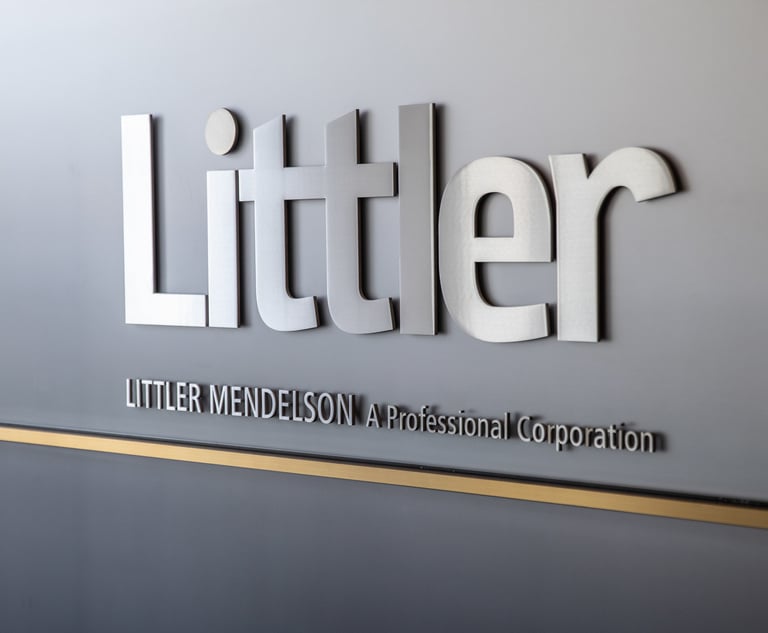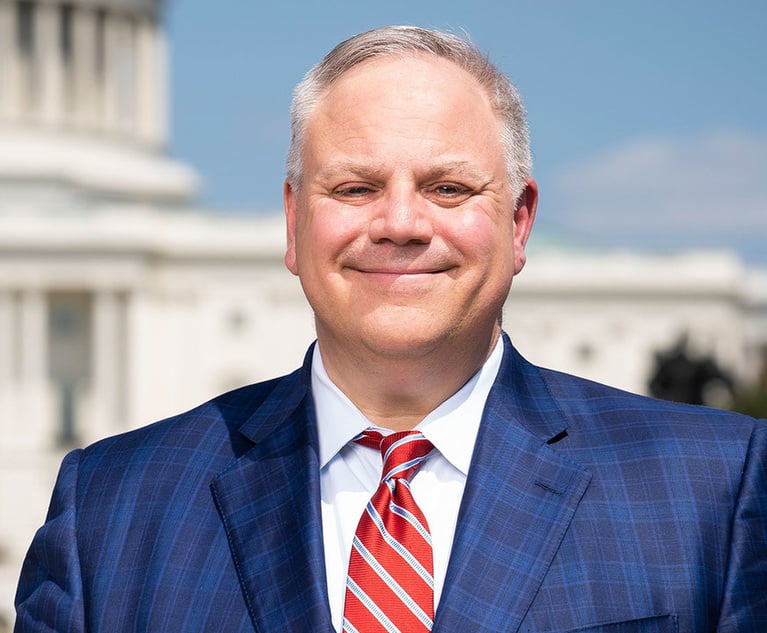If a Recession Is Looming, the Laterals Report Shows Firms Aren't Changing Their Ways
Corporate practices continue to reign supreme in the busy lateral market, even amid whispers of a recession.
February 03, 2020 at 03:25 PM
5 minute read
 Credit: Aldo Crusher
Credit: Aldo Crusher
The Am Law 200 showed an unceasing appetite for corporate talent this year, while bankruptcy partners stayed put—a sign that, even as a recession looms, firms aren't preparing for gloom and doom just yet.
More than 3,100 Big Law partners found new homes this year in a lateral move, with corporate partners accounting for a full 25% of those moves, according to data collected by ALM Intelligence between October 2018 and September 2019.
The total figure is 14.5% higher than last year's lateral total of 2,754, largely as a result of an improved methodology used to collect this year's data, which affects the year-over-year comparison.
Philadelphia-based Fox Rothschild saw the greatest percentage growth via lateral moves, as its partnership ranks swelled by 60, or roughly 18%, on the back of 102 lateral hires, offsetting 42 departures. The firm has been growing steadily since it first cracked the Am Law 200 in 2015. This year, Fox Rothschild's largest pickup was a 15-attorney aviation team that jumped to the firm as LeClairRyan crumbled.
In terms of sheer head count, Greenberg Traurig made the most lateral additions, adding 103 partners (39 others left, for a net of 64). Firm leaders have made it clear that Greenberg is in growth mode, with numerous additions in California, New York and Florida, as well as three office openings in 2019.
Excluding LeClairRyan, which shuttered in August, Irell & Manella's seven net partner defections ranked as the greatest proportion among the Am Law 200 when accounting for the firm's relatively small partnership of around 30. The firm's most notable loss came when its managing partner, David Gindler, jumped to Milbank along with two other intellectual property partners in August. Irell has, for the most part, replenished its head count, boasting 36 partners as of the end of 2019, according to the firm's website.
Winston & Strawn saw the greatest net defections among the Am Law 200, losing 52 partners and adding 17, for a net loss of 35. Notable departures included Jacob Schtevie, who left for White & Case in June after 12 years at the firm, and mergers and acquisitions partner Robert Rawn, who jumped to Jenner & Block in January.
Corporate Is King
At least 580 corporate partners joined the ranks of the Am Law 200, while 469 departed, which adds up to a net gain of 111 partners. Litigation partners accounted for another quarter of the past year's laterals. Banking and finance partners were the third-most-transient practice, comprising nearly 14% of all laterals.
Interestingly enough, given the warnings of a recession, bankruptcy attorneys were the least transient, accounting for just a small fraction of the year's lateral moves, at 2.4%. While it is true that there are fewer bankruptcy partners than corporate or litigation partners, tax shareholders and bankruptcy shareholder populations are about the same, yet tax partners accounted for a greater number of lateral moves, about 3.5%, according to ALM Intelligence data.
And despite a scattering of bankruptcy pickups from firms such as McDermott Will & Emery, Gibson, Dunn & Crutcher and Ropes & Gray, it seems that many firms haven't been too active in responding to a potential downturn in the near future.
"A lot of people are talking about it, but nobody is moving yet," says recruiter Mark Jungers, co-founder of Lippman Jungers.
And why would they? Several surveys and studies have touted 2019 as a very strong year for law firms, with average revenues rising between 5.5% and 6.5%, according to a report by Citi Private Bank's Law Firm Group.
Sharon Mahn, a legal recruiter based in New York, says that simply tacking on bankruptcy partners isn't a surefire guarantee to shore up business anyway. During the Great Recession, many restructuring attorneys were just as empty-handed as their colleagues, and many resorted to rebranding their practices to, say, commercial litigation.
"Firms got burned. The economy was pretty bad, yet a lot of bankruptcy attorneys were out of work," Mahn says.
It isn't just a strong economy that's supercharging the corporate lateral market. The contours of the legal industry—and its winners and losers—are continuing to shift, Jungers says. As has been the case in the last few years, the 25 or so firms that compose the upper tier have continued to pull away from the pack financially. Firms have continued to look for ways to change what Jungers calls the "shape"—or dealmaking prestige and capabilities—of their firms, in hopes that they won't be left behind.
Money has so far seemed to be the most compelling lever. Freshfields Bruckhaus Deringer tripled corporate partner Ethan Klingsberg's reported $3 million salary when it wooed him away from Cleary Gottlieb Steen & Hamilton. Kirkland & Ellis and Paul, Weiss, Rifkind, Wharton & Garrison have also had success enticing talent from lockstep firms. Mark Rosen, the recruiter who orchestrated Klingsberg's move, believes that lockstep firms will cease to exist in the near future. Jungers agrees that lockstep firms are at risk.
"Huge trouble. Enormous trouble. Catastrophic trouble," Jungers says. "Let's say you're 50 and want to practice for another 15 years. If a firm pays you $8 million instead of $4 million, you're talking about life-changing, generational wealth."
Some lockstep firms, such as Debevoise & Plimpton, have actively decided not to change their model. And Jungers adds that it isn't as clear-cut as simply making a bigger paycheck. For one, the target firm has to be able to provide a suitable, strong platform. Often, attorneys turn down a new job for personal reasons. Jungers says he has had three candidates turn down $8 million paydays, even though they took home just half that.
"People are scared, they like their friends, they never thought they'd make $4 million," Jungers says. "There are lots of reasons."
Email: [email protected]
This content has been archived. It is available through our partners, LexisNexis® and Bloomberg Law.
To view this content, please continue to their sites.
Not a Lexis Subscriber?
Subscribe Now
Not a Bloomberg Law Subscriber?
Subscribe Now
NOT FOR REPRINT
© 2025 ALM Global, LLC, All Rights Reserved. Request academic re-use from www.copyright.com. All other uses, submit a request to [email protected]. For more information visit Asset & Logo Licensing.
You Might Like
View All

Three Akin Sports Lawyers Jump to Employment Firm Littler Mendelson

Brownstein Adds Former Interior Secretary, Offering 'Strategic Counsel' During New Trump Term
2 minute read
Law Firms Mentioned
Trending Stories
Who Got The Work
J. Brugh Lower of Gibbons has entered an appearance for industrial equipment supplier Devco Corporation in a pending trademark infringement lawsuit. The suit, accusing the defendant of selling knock-off Graco products, was filed Dec. 18 in New Jersey District Court by Rivkin Radler on behalf of Graco Inc. and Graco Minnesota. The case, assigned to U.S. District Judge Zahid N. Quraishi, is 3:24-cv-11294, Graco Inc. et al v. Devco Corporation.
Who Got The Work
Rebecca Maller-Stein and Kent A. Yalowitz of Arnold & Porter Kaye Scholer have entered their appearances for Hanaco Venture Capital and its executives, Lior Prosor and David Frankel, in a pending securities lawsuit. The action, filed on Dec. 24 in New York Southern District Court by Zell, Aron & Co. on behalf of Goldeneye Advisors, accuses the defendants of negligently and fraudulently managing the plaintiff's $1 million investment. The case, assigned to U.S. District Judge Vernon S. Broderick, is 1:24-cv-09918, Goldeneye Advisors, LLC v. Hanaco Venture Capital, Ltd. et al.
Who Got The Work
Attorneys from A&O Shearman has stepped in as defense counsel for Toronto-Dominion Bank and other defendants in a pending securities class action. The suit, filed Dec. 11 in New York Southern District Court by Bleichmar Fonti & Auld, accuses the defendants of concealing the bank's 'pervasive' deficiencies in regards to its compliance with the Bank Secrecy Act and the quality of its anti-money laundering controls. The case, assigned to U.S. District Judge Arun Subramanian, is 1:24-cv-09445, Gonzalez v. The Toronto-Dominion Bank et al.
Who Got The Work
Crown Castle International, a Pennsylvania company providing shared communications infrastructure, has turned to Luke D. Wolf of Gordon Rees Scully Mansukhani to fend off a pending breach-of-contract lawsuit. The court action, filed Nov. 25 in Michigan Eastern District Court by Hooper Hathaway PC on behalf of The Town Residences LLC, accuses Crown Castle of failing to transfer approximately $30,000 in utility payments from T-Mobile in breach of a roof-top lease and assignment agreement. The case, assigned to U.S. District Judge Susan K. Declercq, is 2:24-cv-13131, The Town Residences LLC v. T-Mobile US, Inc. et al.
Who Got The Work
Wilfred P. Coronato and Daniel M. Schwartz of McCarter & English have stepped in as defense counsel to Electrolux Home Products Inc. in a pending product liability lawsuit. The court action, filed Nov. 26 in New York Eastern District Court by Poulos Lopiccolo PC and Nagel Rice LLP on behalf of David Stern, alleges that the defendant's refrigerators’ drawers and shelving repeatedly break and fall apart within months after purchase. The case, assigned to U.S. District Judge Joan M. Azrack, is 2:24-cv-08204, Stern v. Electrolux Home Products, Inc.
Featured Firms
Law Offices of Gary Martin Hays & Associates, P.C.
(470) 294-1674
Law Offices of Mark E. Salomone
(857) 444-6468
Smith & Hassler
(713) 739-1250









